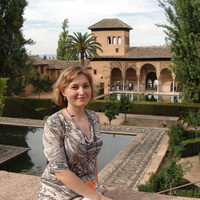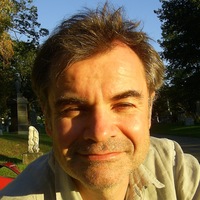
Céline Martin
Related Authors
Michael J. Kelly
Binghamton University
Networks and Neighbours (N&N)
Binghamton University
William Trouvé
Centre d'Etudes Supérieures de la Renaissance, Tours
Jacques Elfassi
Université de Lorraine
Elena Marey
National Research University Higher School of Economics
Deswarte Thomas
Angers University
paula dias
University of Coimbra
Patrick Henriet
EPHE
Marcelo Cândido da Silva
Universidade de São Paulo
thomas deswarte
Angers University
InterestsView All (10)










Uploads
Books by Céline Martin
Papers by Céline Martin
This paper intends to identify the in-laws of Fructuosus of Braga on the basis of the three poems transmitted at the end of the early Vita s. Fructuosi, an anonymous text that was the source for the longer and better known Vita (CPL 1293) of the saint. The study provides a new edition and translation of the poems, two of which are attributed to Fructuosus, and the third one, in praise of him, to an unknown author. We argue that Justa’s husband was a son of the Visigothic king Sisenand and his name was Bricius, whereas Visinand, traditionally so regarded, was in fact the fruit of their marriage. In addition, we propose an identification for the addressee of Fructuosus’s poems and another one, more hypothetical, for the author of the above-mentioned early Vita s. Fructuosi, who was also certainly the one who wrote the third poem.
of Toledo mentioned its alleged imitation of Byzantium as its hallmark,
singling it out from the rest of barbarian Europe. This was not a general
imitatio imperii, but an imitation of the only Roman empire contemporary
to the Gothic polity: eastern, Greek-speaking, exotic Byzantium. This
chapter discusses the origins of Byzantinism in Visigothic historiography, its
occasionally scant grounding in the evidence, and the ideological functions
it fulfijilled for historians. In the twentieth century, the Byzantinist paradigm
produced well-arranged yet often contradictory narratives of one of the
longest-lived post-Roman kingdoms in the West. Only lately has political
and scientifijic globalization dispelled both the illusion of the uniqueness
of Spanish features and the necessity for grounding it in Byzantinism.
(d. 690), the Jews, and the Jewish religion. Julian may have suffered from a twofold stigma: his Jewish familiar background, which quite apart of his Christian faith he must have perceived, as did the rest of Iberian society, as a real otherness, and his support to Count Ervig in overthrowing King Wamba in 680. His procedency as well as his treason could be a cause of torment to Julian, who played a major part in Ervig’s anti-Jewish policy. In his historical works, «Jewish» and «traitor» are concepts deeply associated, which induces to take with caution the mentions he makes to the Jews of the Narbonensis province.
The paper seeks to bring out the common roots and differences between the royal and episcopal functions in the Visigothic kingdom of Toledo. Kings and bishops shared some status markers, as some of their titles and the anointing (although this remained only mystical until the end of the 7th century). They both exerted a rule, either over souls (the bishop) or over secular and ecclesiastical affairs (the king). The king was required to protect his people through war and the guidance of religion, which entailed converting his subjects, sometimes by force, convening councils of bishops, and influencing their agendas. He himself could finally be the subject of an assessment, primarily by the same bishops he had ruled over. Although in the Visigothic kingdom bishops and kings were to meet almost similar requirements to be elected, in the end the latters were likely to be presented by the formers as tyranni, namely anti-kings. The relatedness between king and bishop admitted thus some limits, a difference which would increase in the following centuries.
Rodrigo LAHAM COHEN, "Los judíos entre la Antigüedad Tardía y la Edad Media"
Daniel BOYARIN, "Din como Torá: ¿'Religión judía' en el Kuzari"
Johannes HEIL: "Die Konstruktion der Hispanisch-Jüdischen Geschichte der ersten Jahrhunderte – ein Versuch"
Catherine HEZSER, "Bookish Circles? The Use of Written Texts in Rabbinic Oral Culture"
Celine MARTIN, "Los judíos y la peste: la excepción narbonense a la persecución de 694"
Gilvan Ventura da SILVA, "João Crisóstomo e a censura aos festivais judaicos de Antioquia"
The terminology used by Visigothic Christian authors shows that they saw the Jews as a people united by blood and descended from one ancestor. Religious characterisations applied to them refer to their choice, a wrong but rectifiable one, which therefore doesn’t stand at the root of their definition as a group. This “choice” is the main argument for calling them heretics, in the broadest sense of this polysemous word, whereas no connection can be found between Jews and Pagans in the sources. The last book of the Visigothic law code cracks down at the same time on heretics and Jews, maybe due to the fact that, in the second half of the seventh century, both are equally viewed as flawed Christians.
This paper intends to identify the in-laws of Fructuosus of Braga on the basis of the three poems transmitted at the end of the early Vita s. Fructuosi, an anonymous text that was the source for the longer and better known Vita (CPL 1293) of the saint. The study provides a new edition and translation of the poems, two of which are attributed to Fructuosus, and the third one, in praise of him, to an unknown author. We argue that Justa’s husband was a son of the Visigothic king Sisenand and his name was Bricius, whereas Visinand, traditionally so regarded, was in fact the fruit of their marriage. In addition, we propose an identification for the addressee of Fructuosus’s poems and another one, more hypothetical, for the author of the above-mentioned early Vita s. Fructuosi, who was also certainly the one who wrote the third poem.
of Toledo mentioned its alleged imitation of Byzantium as its hallmark,
singling it out from the rest of barbarian Europe. This was not a general
imitatio imperii, but an imitation of the only Roman empire contemporary
to the Gothic polity: eastern, Greek-speaking, exotic Byzantium. This
chapter discusses the origins of Byzantinism in Visigothic historiography, its
occasionally scant grounding in the evidence, and the ideological functions
it fulfijilled for historians. In the twentieth century, the Byzantinist paradigm
produced well-arranged yet often contradictory narratives of one of the
longest-lived post-Roman kingdoms in the West. Only lately has political
and scientifijic globalization dispelled both the illusion of the uniqueness
of Spanish features and the necessity for grounding it in Byzantinism.
(d. 690), the Jews, and the Jewish religion. Julian may have suffered from a twofold stigma: his Jewish familiar background, which quite apart of his Christian faith he must have perceived, as did the rest of Iberian society, as a real otherness, and his support to Count Ervig in overthrowing King Wamba in 680. His procedency as well as his treason could be a cause of torment to Julian, who played a major part in Ervig’s anti-Jewish policy. In his historical works, «Jewish» and «traitor» are concepts deeply associated, which induces to take with caution the mentions he makes to the Jews of the Narbonensis province.
The paper seeks to bring out the common roots and differences between the royal and episcopal functions in the Visigothic kingdom of Toledo. Kings and bishops shared some status markers, as some of their titles and the anointing (although this remained only mystical until the end of the 7th century). They both exerted a rule, either over souls (the bishop) or over secular and ecclesiastical affairs (the king). The king was required to protect his people through war and the guidance of religion, which entailed converting his subjects, sometimes by force, convening councils of bishops, and influencing their agendas. He himself could finally be the subject of an assessment, primarily by the same bishops he had ruled over. Although in the Visigothic kingdom bishops and kings were to meet almost similar requirements to be elected, in the end the latters were likely to be presented by the formers as tyranni, namely anti-kings. The relatedness between king and bishop admitted thus some limits, a difference which would increase in the following centuries.
Rodrigo LAHAM COHEN, "Los judíos entre la Antigüedad Tardía y la Edad Media"
Daniel BOYARIN, "Din como Torá: ¿'Religión judía' en el Kuzari"
Johannes HEIL: "Die Konstruktion der Hispanisch-Jüdischen Geschichte der ersten Jahrhunderte – ein Versuch"
Catherine HEZSER, "Bookish Circles? The Use of Written Texts in Rabbinic Oral Culture"
Celine MARTIN, "Los judíos y la peste: la excepción narbonense a la persecución de 694"
Gilvan Ventura da SILVA, "João Crisóstomo e a censura aos festivais judaicos de Antioquia"
The terminology used by Visigothic Christian authors shows that they saw the Jews as a people united by blood and descended from one ancestor. Religious characterisations applied to them refer to their choice, a wrong but rectifiable one, which therefore doesn’t stand at the root of their definition as a group. This “choice” is the main argument for calling them heretics, in the broadest sense of this polysemous word, whereas no connection can be found between Jews and Pagans in the sources. The last book of the Visigothic law code cracks down at the same time on heretics and Jews, maybe due to the fact that, in the second half of the seventh century, both are equally viewed as flawed Christians.
Вестготская Правда (Книга Приговоров). Латинский текст. Перевод. Исследование, dir.
O. V. Aurov, A. V. Marey, Moscú, Русский Фонд Содействия Образованию и Науке, 2012
(Исторические источники), 944 págs., ISBN: 978-5-91244-069-4.
Ibérique. À partir des récentes données archéologiques et des recherches actuelles qui portent sur l’interprétation et la connaissance historique des sources écrites, nous analyserons le processus général, et particulier, de la transformation
des villes et de leurs territoires, en insistant sur le modèle de mise en oeuvre dans la partie occidentale de la Méditerranée. En prenant la capitale de Tolède comme centre du débat, nous aborderons les précédents urbains du Bas-Empire, le développement d’une progressive transformation sociale, économique, politique et religieuse, ainsi que les autres éléments de changement et de continuité qui ont également contribué à façonner de nouveaux paysages
culturels durant l’Antiquité tardive. L’itinérance de la cour et de la monarchie wisigothes dans plusieurs villes gauloises et hispaniques, jusqu’à son installation
définitive à Tolède, a dû engendrer des conséquences topographiques particulières et un aménagement conséquent du territoire pour chacune d’entre elles, qui se reflètent tant dans la structuration des nouveaux espaces publics
et de représentation, que dans ceux du domaine privé ou résidentiel. On peut donc se deman- der dans quelle mesure les fondations civiles sous patronage royal et les structures qui intègrent les itinéraires saisonniers promus par le pouvoir
ecclésiastique ont contribué au développement et à la configuration d’une nouvelle image de la ville tardoantique, ville qui aura sa dernière expression à Oviedo au moment de la naissance du royaume asturien.
Galia, en primer lugar, y posteriormente en la Península Ibérica. A partir de las recientes evidencias arqueológicas, y de manera paralela, de las investigaciones actuales versadas
en la interpretación y conocimiento histórico de las fuentes escritas, se indagará en el proceso general y particular de transformación de las ciudades y de sus territorios, insistiendo
en el modelo de implantación territorial de este pueblo en la parte del Mediterráneo occidental. Tomando como centro del discurso la capital de Toledo, se abordarán los precedentes
urbanos bajoimperiales y el desarrollo inicial de una progresiva transformación social, económica, política y religiosa, así como en aquellos otros elementos de cambio y continuidad que también contribuyeron a delinear unos nuevos paisajes culturales a lo largo de la Antigüedad tardía. La residencia itinerante de la corte y de la monarquía visigoda
en diversas ciudades galas e hispánicas, hasta su definitiva instalación en Toledo, debió acarrear consecuencias topográficas particulares en cada una de ellas, tanto en la propia estructuración de los nuevos espacios públicos y de representación, además de aquéllos de ámbito privado o residencial, como en la ordenación del territorio. Se pretende, por tanto, rastraer en qué medida las fundaciones civiles de patronato regio, y también las estructuras que integraban los itinerarios estacionales promovidas por el poder eclesiástico,
contribuyeron al desarrollo y configuración de una nueva imagen de la ciudad tardoantigua que tendrá su última expresión en Oviedo con el inicio del reino asturiano.
Le principal objectif de ce colloque est de s’interroger sur les manifestations urbaines et architecturales des nouvelles élites wisigothiques à travers leurs sedes regiae établies
en Gaule, dans un premier temps, et plus tard dans la péninsule Ibérique. À partir des récentes données archéologiques et des recherches actuelles qui portent sur l’interprétation et la connaissance historique des sources écrites, nous analyserons le processus général, et particulier, de la transformation des villes et de leurs territoires, en insistant
sur le modèle de mise en oeuvre dans la partie occidentale de la Méditerranée. En prenant la capitale de Tolède comme centre du débat, nous aborderons les précédents urbains
du Bas-Empire, le développement d’une progressive transformation sociale, économique, politique et religieuse, ainsi que les autres éléments de changement et de continuité qui ont également contribué à façonner de nouveaux paysages culturels durant l’Antiquité tardive. L’itinérance de la cour et de la monarchie wisigothes dans plusieurs villes gauloises et
hispaniques, jusqu’à son installation définitive à Tolède, a dû engendrer des conséquences topographiques particulières et un aménagement conséquent du territoire pour chacune
d’entre elles, qui se reflètent tant dans la structuration des nouveaux espaces publics et de représentation, que dans ceux du domaine privé ou résidentiel. On peut donc se demander
dans quelle mesure les fondations civiles sous patronage royal et les structures qui intègrent les itinéraires saisonniers promus par le pouvoir ecclésiastique ont contribué au développement et à la configuration d’une nouvelle image de la ville tardoantique, ville qui aura sa dernière expression à Oviedo au moment de la naissance du royaume asturien.
Seventh-century Bierzo had inherited most of the Roman framework of public roads and settlements. These are the concern of the second section of this essay: across Bierzo at least one Roman road joined Asturica, to the East, with Bracara in Gallaetia; there may have been another itinerary between Asturica and Bergidum, capital of the region, but scholars today tend to doubt the existence of two different roads. The otherplaces named by Valerius are a castrum (Castrum Petrense) and several monasteries, the locations of which are in some cases quite certain and in others still unclear.
The last section of this essay deals with Asturia as an administrative entity. Although included in the Diocletianic province of Gallaetia, it has been claimed, since the 1970s, that Asturia was promoted to a new independent province some time in the seventh century; the main argument for this theory has been taken precisely from Valerius’s works. However, such an idea is insufficiently supported, whether by Valerius’s writings or by the few other pieces of available evidence: the lack of a stronger foundation for the theory should prevent scholars from considering Asturia, Valerius’s patria, as anything other than an ecclesiastical diocese.
Les élites chrétiennes mirent rapidement au service du pouvoir la rhétorique de la justification divine tant pour exalter le souverain que l’inviter à conformer ses actes à la parole du Christ. Dans la représentation du pouvoir par les contemporains lettrés et dans son autoreprésentation à travers les textes, les monuments et les images, le souverain assuma le modèle mis à sa disposition, quitte à en jouer pour servir les besoin de l'heure.
Après avoir abordé en 2008 la question de la christianisation du monde antique analysée dans ses aspects documentaires et régionaux, puis en 2013 celle du passage des dieux civiques aux saints patrons qui constitua moins une succession fonctionnelle qu’un hiatus dans la vie communautaire, l’université de Paris Nanterre a mené en octobre 2016 une réflexion collective, internationale et transversale sur les relations entre le Prince et le christianisme dans le contexte de l’Empire tardif et des royaumes issus de sa dislocation.
Le propos fut non seulement de mesurer l’influence de la religion dans l’idéalisation du pouvoir, mais encore d’étendre les perspectives de recherche aux principaux domaines d’exercice de l’autorité suprême. L’image du Prince se refléta en effet dans ses rapports avec les élites et avec les marges, avec les fidèles chrétiens et non-chrétiens, avec ses adversaires intérieurs et extérieurs. Entre le IVe et le VIIIe siècle, la notion de Prince chrétien constitua peut-être moins une donnée du réel qu'un revendication à illustrer et à défendre.